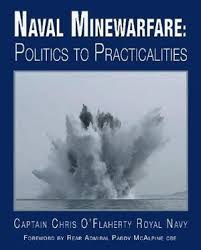
Naval Minewarfare. Politics to Practicalities. By Captain Chris O’Flaherty, RN. The Choir Press, Gloucester, U.K. 2019. xvii + 394 pp, illustrations, diagrams, tables, notes, annexes, bibliography, index. £34.99; ISBN 978-1-78963-086-2. Available through Amazon, Indigo, Walmart and elsewhere.
Reviewed by Fraser McKee*
This fascinating volume is one long overdue, by an expert. CAPT Chris O’Flaherty, RN, is Captain, Maritime Warfare Centre at HMS Collingwood, has spent much of his career involved with clearance diving and mine warfare. While the first 50 pages are a general review of the development of mines and mine warfare, this volume concentrates on the principles of the threat; the current ongoing use of this ‘pernicious’ device; a review of the rarely observed legalities involved.
These are surprisingly still measured by infractions to the Hague Convention of 1909. For civilized nations, these are conceived as applicable at least in part by major powers. Just not from most of those employing mines these current days.
The author provides a fascinating, and educational, recording of mining use in 24 tactical and operational occasions throughout the world since the end of the Second World War. This is a sobering review of the actual recent and on-going use of sea mines. The problems faced by various warships and merchantmen, from the severe damage to two RN destroyers in the Corfu Channel in 1946, in a supposedly free passageway, through sea mine use in the Indo-China war of 1965-1973, the Falklands in 1982, the Gulf War in 1991 (where Canada’s ships had to be cautious of them), and more recently off Yemen in 2017. (Chapter 3, pp.57- 161, + 15 pages of published reference notes to these events). Each a tale of threatened or actual encounter with opposition mining, some of several pages. In itself this section is a serious warning to those who may regard this ancient weapon of little or easily handled concern; ‘just a threat.’ It’s not just that – it’s actually in use.
The major point of Captain O’Flaherty’s work is to serve as that warning. Throughout, he makes the point that while publicised mining of sea passages and harbour approaches may be complied with, by civilized major nations who at least notionally are adhering to those 1909 Hague Peace Conference Conventions, at published warnings to allow free passage to non-belligerent ships, the rise of inter-nation squabbles and outright wars by semi-rogue states has lead to completely unregulated sea mining, costing many ships – and lives. And due to the availability of some relatively simple mining devices, manufactured or obtained by the smallest of non-state organizations. He goes into and provides diagrams of increasing levels of possibility, threat … and actuality. The correlation of effort to threat to measures of success, not necessarily related to ships sunk. That is too easy a measurement. The threat of mining is its major advantage, at almost nil cost.
The final chapter headings indicate the value of this text above the normal ‘this is what happened’ earlier books on minewarfare: ‘The Law of Naval Mining’ and ‘of Naval Mine Countermeasures,’ ‘The Statecraft of Naval Minewarfare.’ His conclusions in ‘Measures of Effect’ and his valuable actual ‘Conclusions (pp336-342)’ are what give importance to this volume as different from earlier histories of the use of mines as a mere adjunct to wider naval warfare.
Thus this text should not only be on the bookshelves of those navally responsible for preparations to meet the threat of hostile mining of our harbours and passages, such as the St. Lawrence estuary, but available to those providing the funding for at least a minimal countermeasure. Here Captain O’Flaherty gives a close scrutiny of what is required in statecraft to meet the all too real threat alone. The application of preparations to deal with the potential mining of ours ports, quite possibly by the most minor of groups – not major civilized powers even – is where this volume is at its most valuable here. An unusual, an essential, read for quite a range of leaders, apart from anyone with an interest in the subject.
*Cdr., RCNR, ret’d. McKee served in the wartime RCNVR and Reserves until 1978, specializing in anti-submarine warfare. He has written or co-authored six books, plus a paper on the RCN’s need for MCMV vessels for the Naval Officer’s Association, when the RCN had none. He has had a major interest in mine warfare and was a strong proponent for the introduction of the Navy’s MCDV ships. At 95, he lives and still prepares book reviews, such as this one, for the NAC’s ‘Starshell’ and the Canadian Nautical Research Society’s ‘The Northern Mariner,’ from which this is an excerpt.



